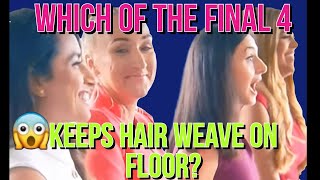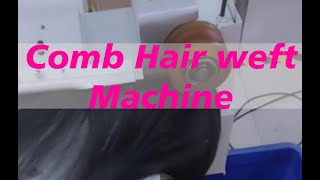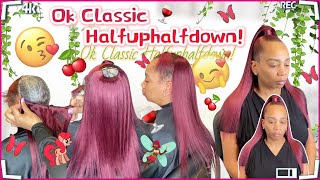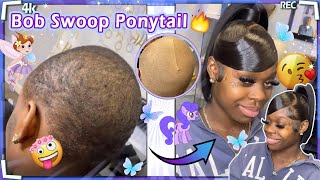Christina Jenkins Invented The Sew In Weave Process In 1951
- Posted on 13 February, 2018
- Hair Knowledge
- By Anonymous
CHRISTINA JENKINS INVENTED THE SEW IN WEAVE PROCESS IN 1951
Good morning, good evening, wherever you may be, I hope you feeling blessed and having a good morning. This is authentic. Epic boom was up with you, epic boomers, wrench squad - viewers - hey hey, hope you all are doing good. Let me know how you doing in the comment section and we're gon na get into a little bit of black history, that I find fascinating, interesting and very intriguing. This beautiful african-american lady that you're looking at her name, is Christina Jenkins and she actually created the sewing weave back in 1951. Me give you a little background on her. Okay, you see here Christina Jenkins, invented hair weaving process. In the 1950s, she received a patent in 1951 for this process of hair weaving. Although people were wearing wigs and hair pieces for thousands of years, Christina came up with this weaving idea. She was married to a jazz musician named Duke at the time, and they lived in Cleveland, Ohio, Christina and Duke Jenkins formed their company. Christina Hair Weave, which have spelled Christina's hair and it was a WTB, is how they spell. We back that interesting in the early 1950s. People were so in love with her hair, weaves and methods of applying them that they would pay her to come to their country and teach them how to sew in hair weave before she invented the idea to sew. In the hair onto the hair, people were putting I'm sorry putting the weave on hair pins placed on Scouts, hair weave back in those days were stiff and pretty bulky. I can imagine mrs. Jenkins technique at the first look. The same was once done what she did for the hair extension world was created a way for it to be applied and stay for a while. Thank goodness for her. Her technique at the time was very time-consuming its time-consuming. Now I'm sorry, but it is time-consuming now, because it's a whole process. You know what not and it does take time, but in the 1950s the way she would do a sewing we, according to the padding and it included. Now, I'm going to show you what she will the last patrasche found of her, and then I will show you some instructions and some illustrations, which I find very fascinating for how they did it then, to how we do hair weave now so shout out to her And I'll be right back now. This is the last picture I was able to find of her. I think she's still beautiful and I just think is a beautiful thing that you know anyone that's african-american has created something so not only trendy but timeless. I know I've worn hair weaves over the last. Not ten years got to start wearing them until, like my thirties, always wore my own hair before that. But it's a way to do something different. It'S a way for you to grow your hair. It'S a way to you know, try different colors. If you want to do cuz, it's just so many reasons why we do we do depending on who you are, but it's it's a great way to try something new and do something beyond the norm. So I'm grateful to her I'm grateful her technique, her ideas, her and her husband's company. I even like the way they spill weave wev. We spell it differently now, of course, but you know I'm gon na show you. I just wanted to show you the last picture. I found of her and I'm gon na, read to you and show you some patterns of how things were going so I'll, be right back again. Is it isn't that beautiful her then her? Now, okay, I'll be right back or actually you know what I won't even do that, let's keep it going. So this is one of the illustrations here: okay, one of them one of them beautiful illustrations and me read you a little bit of what it says here. Connecting successive strands of live, hair answers of the strands of commercial hair to a minor jury attachment based on a court like material at closely placed points thereof and there alone interweaving strands of live, hair and strands of commercial hair with courts like materials permanently join the Strands thereto, interweaving, strands of live hair, with materials of permanent secure of the materials as a base on the head and attaching a switch or like assess accessory a commercial hair to a base by threads. Now, for me to look at this, I see some similarities. I see why it's bulky, because how they're applying it and the hair was not braided in as far as what we consider so him versus the 1950s. I find that interesting to look at how they you know attached it. Interline did what's the word, I'm looking for. It'S it's! It'S is this the way it's just inner embedded, that's the best way. I could put it now that I've, given you a little bit of history on Cristina Jenkins, her husband hair company, he was a jazz pianist, Herrmann Duke Jenkins, oh wow. She passed away in 2003, god rest, her soul. You know from 1950s to where we are in 2018. It'S interesting how I always have come a long way and I'm thankful for her her abilities to create this, to give us something different. You know it's good to be able to intertwine and change things if you want to you know the drop of a hat or be able to get something that will not only look nice but actually do great things for your hair. So I'm gon na show you some illustrations of how this came together from one I believe to 11 of how she did this, and I find it interesting and you will see her the bottom. The pictures you will see the mentor. You will see her how she actually autographed it in everything. So, let's get to the you





Comments
Co Co Patrice: It doesn't take that long if you're a fast neat braider and sewer. Takes me 2 hours 2 1/2 if being curled. Getting individual braids takes way more time than that.
cold Pepsi: Christina,We THANK YOU.Good one Epic
Moca Coco: She is very Beautiful
Rochelle Bailey: This was very interesting. I never heard of her before. Tfs
LR: This is cool
Gwendolyn Pearson: The hair us installed with a needle
Ms Ashanti Dawson: Good afternoon ' Ms Boom ' hope u have a great day